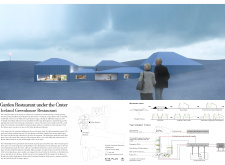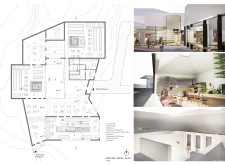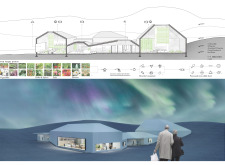5 key facts about this project
The primary function of the restaurant is to offer an immersive culinary experience that connects diners with locally sourced ingredients, cultivated through hydroponic farming systems incorporated into the building. This approach promotes the concept of farm-to-table dining, enhancing the visitor's understanding of the food production process.
The architectural layout comprises several interconnected structures characterized by asymmetrical roofs that reflect the natural topography of the crater. This design facilitates optimal light and energy flow, contributing to the greenhouse's efficiency. Transparency is a key feature, with extensive use of glass allowing uninterrupted views of the volcanic landscape, encouraging patrons to engage with their surroundings.
The material palette includes concrete, glass, metal cladding, renewable wood, and naturally fertile soils for vertical gardens. This selection aligns with the sustainability goals of the project while creating a modern atmosphere conducive to dining. The incorporation of vertical gardening systems within the interior reflects an innovative use of space, enabling fresh produce growth while enhancing the aesthetic quality of the interior environment.
The Garden Restaurant under the Crater is distinguished by its commitment to sustainability and community engagement. The integration of geothermal resources for energy and hydroponic systems for food production showcases a design philosophy centered around ecological responsibility. Additionally, the restaurant serves as an educational platform, where visitors can participate in horticultural activities and learn about sustainable practices.
The thoughtful architectural design also accommodates diverse visitor experiences. Flexible dining areas encourage both communal gatherings and intimate settings. The open kitchen layout fosters interaction between chefs and guests, emphasizing transparency in food preparation.
This architectural project represents a significant advance in sustainable dining concepts, merging environmental integration with culinary arts. For a deeper exploration of its architectural plans, sections, designs, and ideas, potential visitors and enthusiasts are encouraged to review the project presentation for comprehensive insights.


























